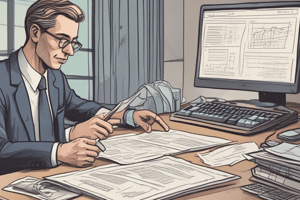Podcast
Questions and Answers
Which provision of the Sarbanes-Oxley Act directly aims to prevent accounting fraud by ensuring independent oversight?
Which provision of the Sarbanes-Oxley Act directly aims to prevent accounting fraud by ensuring independent oversight?
- Increased accountability for corporate executives.
- Ending the "too big to fail" doctrine.
- Establishment of the Public Company Accounting Oversight Board (PCAOB). (correct)
- Enhanced financial disclosures.
How did the Dodd-Frank Act address the issue of interconnectedness of financial institutions that contributed to the 2008 crisis?
How did the Dodd-Frank Act address the issue of interconnectedness of financial institutions that contributed to the 2008 crisis?
- By deregulating the housing market.
- By increasing financial disclosures for all companies.
- By ending the "too big to fail" doctrine. (correct)
- By establishing the Public Company Accounting Oversight Board (PCAOB).
What role did Credit Default Swaps (CDSs) play in the 2008 financial crisis?
What role did Credit Default Swaps (CDSs) play in the 2008 financial crisis?
- They were not a factor in the 2008 financial crisis.
- They provided a stable source of revenue for financial institutions.
- They insured assets like CMOs, but also amplified systemic risk. (correct)
- They decreased market volatility by limiting speculation.
Which of the following accurately reflects the consequences of the Great Recession?
Which of the following accurately reflects the consequences of the Great Recession?
How did the deregulation of the airline industry in 1978 affect airfares and the number of passengers?
How did the deregulation of the airline industry in 1978 affect airfares and the number of passengers?
Which factor primarily explains why airfares decreased following the deregulation of the airline industry?
Which factor primarily explains why airfares decreased following the deregulation of the airline industry?
What is 'regulatory capture,' and how did it manifest in the pre-deregulation airline industry?
What is 'regulatory capture,' and how did it manifest in the pre-deregulation airline industry?
What is a potential negative outcome of deregulation?
What is a potential negative outcome of deregulation?
Which of the following scenarios exemplifies regulatory capture?
Which of the following scenarios exemplifies regulatory capture?
Flashcards
Sarbanes-Oxley Act (2002)
Sarbanes-Oxley Act (2002)
Restored confidence in financial reporting and protected investors from accounting fraud.
Dodd-Frank Act (2010)
Dodd-Frank Act (2010)
Promoted financial stability and protected consumers after the 2008 financial crisis.
Collateralized Mortgage Obligations (CMOs)
Collateralized Mortgage Obligations (CMOs)
Mortgage-backed securities that were poorly rated and contributed to the 2008 financial crisis.
Credit Default Swaps (CDSs)
Credit Default Swaps (CDSs)
Signup and view all the flashcards
Deregulation Act of 1978 (Airlines)
Deregulation Act of 1978 (Airlines)
Signup and view all the flashcards
Regulatory Capture
Regulatory Capture
Signup and view all the flashcards
Positive Outcomes of Deregulation
Positive Outcomes of Deregulation
Signup and view all the flashcards
Negative Outcomes of Deregulation
Negative Outcomes of Deregulation
Signup and view all the flashcards
Study Notes
Key Legislative Responses
- The Sarbanes-Oxley Act was established in 2002 to restore trust in financial reporting and protect investors from accounting fraud.
- As part of the Sarbanes-Oxley Act, corporate executives became more accountable and financial disclosures were enhanced.
- The Sarbanes-Oxley Act established the Public Company Accounting Oversight Board (PCAOB) to oversee public company audits.
- The Dodd-Frank Wall Street Reform and Consumer Protection Act was established in 2010 to improve financial stability and protect consumers, following the 2008 financial crisis.
- The Dodd-Frank Act improved accountability and transparency in the financial system, and ended the "too big to fail" doctrine.
- As part of the Dodd-Frank Act, the Consumer Financial Protection Bureau (CFPB) was established to oversee financial products and services.
The Great Recession (2007-2009)
- The Great Recession was triggered by the failure of unregulated financial assets, known as the Global Financial Crisis.
- Collateralized Mortgage Obligations (CMOs) were mortgage-backed securities that were poorly rated.
- Credit Default Swaps (CDSs) are insurance contracts on assets like CMOs that created systemic risk.
- Major financial institutions, including Lehman Brothers and Fannie Mae, collapsed during the Great Recession
- The Great Recession caused a widespread economic downturn and a loss of consumer confidence in financial markets.
Impact of Deregulation in Various Industries
- From 1938 to 1978, the Civil Aeronautics Board (CAB) regulated fares and routes, which limited competition in the airline industry.
- The Deregulation Act of 1978 removed government control over airline prices and routes.
- Following deregulation, airfares decreased by about one-third.
- Increased competition following deregulation led to more efficient airline operations, like hub-and-spoke systems.
- The number of air passengers doubled after deregulation, creating more jobs in the industry.
- Regulatory capture is when regulated firms influence regulators to create favorable conditions.
- Airlines had significant sway over CAB decisions during regulation, leading to higher prices and reduced competition.
Evaluating the Effects of Deregulation
- Increased competition typically results in lower prices and improved services for consumers.
- Greater market efficiency and innovation occur due to reduced barriers for new entrants.
- Increased market volatility and risk of bankruptcies can lead to job losses.
- There is potential for regulatory capture, which can undermine consumer protection.
Studying That Suits You
Use AI to generate personalized quizzes and flashcards to suit your learning preferences.




